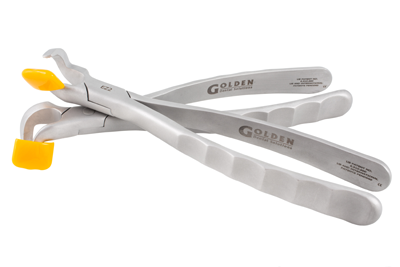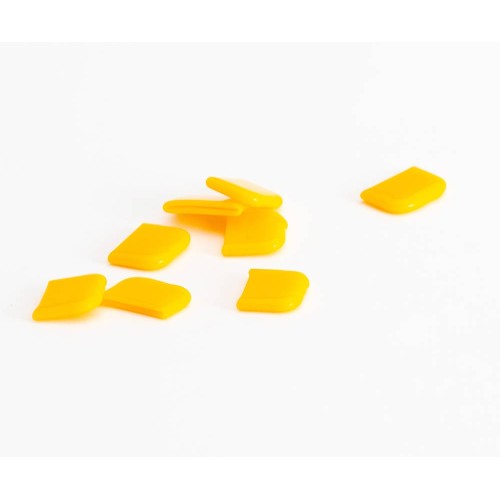Physics Forceps® Molar Series
 Physics Forceps™ continues to be, quite simply, the easiest to use and most clinically effective tooth extraction instrument on the market. The patented designs of our instruments and its associated patented Beak & Bumper™ technique make difficult extractions simple and predictable for all dentists without utilizing brute strength. Do your patients, your hands - and your practice - a favor, and implement the Physics Forceps into your practice today.
Physics Forceps™ continues to be, quite simply, the easiest to use and most clinically effective tooth extraction instrument on the market. The patented designs of our instruments and its associated patented Beak & Bumper™ technique make difficult extractions simple and predictable for all dentists without utilizing brute strength. Do your patients, your hands - and your practice - a favor, and implement the Physics Forceps into your practice today.The Physics Forceps operate as a dental elevator rather than a forcep (as the name implies), and it uses first-class lever mechanics. One handle is connected to the "bumper", which acts as the fulcrum during the procedure and the other handle is connected to the "beak", which is positioned most often on the lingual or palatal root of the tooth into the gingival sulcus. The Bumper is positioned most often on the facial aspect at the mucogingival junction.
Once the instrument is properly placed, no squeezing pressure is applied to the handles or the tooth, where instead the handles are rotated a few degrees with only wrist movement until you get resistance. Once you get resistance, the rotation is stopped and the instrument is held in place for a short period of time. During this holding period, the "creep" will build, releasing hyaluronic acid, and breaking down the periodontal ligaments. If the tooth does not move during this initial hold, this process should be continued where the handles are rotated another few degrees. This constant and steady pressure is continued until the tooth releases and moves 1-3mm. At this stage, the tooth is loose in the socket and should be delivered with a pincer-like device. Used properly the buccal bone is preserved and undamaged.
The Physics Forceps with its steady unrelenting trauma to the periodontal ligament quantitatively creates a greater release of hyaluronidase in a shorter period of time than traditional forceps or elevator extractions because the trauma from those techniques is intermittent. This is what makes the Physics Forceps more efficient, faster, and less traumatic to the alveolar bone than other extraction instruments and techniques.
 Separate the gingival attachment from the tooth. All upper teeth, including molars can be extracted without any sectioning. Lowers molars occasionally need to be sectioned (lingual buccal) to ensure a more predictable extraction, by significantly reducing resistance to extracting forces.
Separate the gingival attachment from the tooth. All upper teeth, including molars can be extracted without any sectioning. Lowers molars occasionally need to be sectioned (lingual buccal) to ensure a more predictable extraction, by significantly reducing resistance to extracting forces. With the handles wide open, set the beak into the depth of the lingual or palatal sulcus on solid root surface. A secure purchase point on solid root surface is critical to successfully rolling out the tooth. When necessary, create a small trench with a small flame shaped diamond burr to engage the beak more securely on solid root surface.
With the handles wide open, set the beak into the depth of the lingual or palatal sulcus on solid root surface. A secure purchase point on solid root surface is critical to successfully rolling out the tooth. When necessary, create a small trench with a small flame shaped diamond burr to engage the beak more securely on solid root surface. Set the bumper perpendicular to the tooth at about the level of the mucogingival junction. Holding that position securely, freeze don't squeeze the handles. Note: the greater the distance between the beak and the bumper, the greater the arc of rotation, consequently achieving vertical lift.
Set the bumper perpendicular to the tooth at about the level of the mucogingival junction. Holding that position securely, freeze don't squeeze the handles. Note: the greater the distance between the beak and the bumper, the greater the arc of rotation, consequently achieving vertical lift. Separate the gingival attachment from the tooth. All upper teeth, including molars can be extracted without any sectioning. Lowers molars occasionally need to be sectioned (lingual buccal) to insure a more predictable extraction, by significantly reducing resistance to extracting forces.
Separate the gingival attachment from the tooth. All upper teeth, including molars can be extracted without any sectioning. Lowers molars occasionally need to be sectioned (lingual buccal) to insure a more predictable extraction, by significantly reducing resistance to extracting forces. Without squeezing the handles or moving your arm, begin to apply a steady, very slow rotational force in the direction of the bumper patiently, continue to apply this steady force for 30 to 40 seconds. This force or creep will continue to build, allowing time for the periodontal ligament to release, the bone to slowly expand & the tooth to disengage.
Without squeezing the handles or moving your arm, begin to apply a steady, very slow rotational force in the direction of the bumper patiently, continue to apply this steady force for 30 to 40 seconds. This force or creep will continue to build, allowing time for the periodontal ligament to release, the bone to slowly expand & the tooth to disengage. Initially, you may want to avoid unnecessary damage to the buccal plate by not proceeding with the Physics Forceps beyond the first sign of the tooth 'popping' loose. If the tooth has not elevated sufficiently to grasp it with your fingers, consider using a hemostat, rongeurs or conventional forceps to lift it out.
Initially, you may want to avoid unnecessary damage to the buccal plate by not proceeding with the Physics Forceps beyond the first sign of the tooth 'popping' loose. If the tooth has not elevated sufficiently to grasp it with your fingers, consider using a hemostat, rongeurs or conventional forceps to lift it out.Bumper Guards for GMX-400 Molar Series
Prices change with available options
GMX-300 - Posterior Series Bumper Guards Lowers
Prices change with available options
GMX 400 Molar Series - EZ1
$569.00
Misch M1 and M2 / Misch Power Elevators (GMX-BG-MPE)
Prices change with available options
GMX 400 Molar Series - EZ2
$569.00
Showing 1 to 6 of 6 (1 Pages)

-500x500.jpg)


-500x500.jpg)
-500x500.jpg)